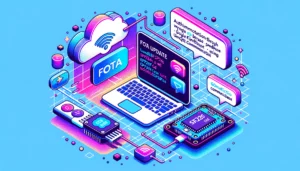An In-Depth Look at Biometrics in IoT Security

Introduction to Biometrics
Biometrics refers to the technology that measures and analyzes human physical and behavioral characteristics. These characteristics are unique to each individual, making biometrics a reliable way to verify identity.
Common Examples Like Fingerprints and Face Recognition
Examples of biometrics include fingerprint recognition, face recognition, iris scanning, voice recognition, and even gait analysis. Among these, fingerprint and face recognition are perhaps the most well-known and widely used.
- Fingerprint Recognition: This method involves scanning a person’s fingerprint and matching it to a stored image. It’s a common feature in smartphones and laptops for authentication.
- Face Recognition: Often used in security systems, this technology analyzes facial features to verify a person’s identity. It can be found in devices like smartphones and security cameras.
How They Are Used in Everyday Life
Biometrics has found its way into various aspects of everyday life, thanks to its convenience and reliability.
- Personal Devices: Many smartphones and laptops now use fingerprint or facial recognition for unlocking.
- Secure Access: In workplaces, biometric systems may control access to sensitive areas.
- Law Enforcement: Police and other authorities may use biometric data to identify suspects or verify the identity of individuals.
- Travel Security: Airports increasingly employ biometric verification for expedited security checks.
How Biometrics Work
Different Types of Biometric Systems
Biometric systems can be broadly categorized into two groups:
- Physical Biometrics: These involve the physical traits of a person, such as fingerprints, facial structure, and eye retina or iris.
- Behavioral Biometrics: These are related to the behavior of a person, such as voice pattern, signature, and typing rhythm.
How They Gather Information
- Scanning and Capturing: Biometric devices use sensors to scan and capture data. For example, a fingerprint scanner will capture the pattern of ridges and valleys in a fingerprint.
- Processing and Storing: Once captured, the data is processed and converted into a format that can be stored and compared. This involves complex algorithms that analyze and encode the information.
- Matching and Verification: When authentication is needed, the system captures the biometric data again and compares it to the stored version. If there’s a match, access is granted.
The Technology Behind Reading and Matching Biometric Data
Understanding the specific technology behind reading and matching biometric data requires a look at the algorithms and sensors used.
- Algorithms: These are mathematical formulas used to process and compare biometric data. They must be precise and efficient to ensure accurate matching.
- Sensors: Different biometric traits require specialized sensors. For example, fingerprint scanners may use optical or ultrasonic sensors, while facial recognition systems often rely on cameras equipped with infrared technology.
Biometrics and IoT Security
What IoT Is and Why Security Is Important
IoT, or the Internet of Things, refers to the network of interconnected devices and objects that communicate with each other through the internet. With the growth of IoT, security has become a paramount concern, as vulnerabilities can lead to unauthorized access and potential misuse.
How Biometrics Can Help Make IoT Devices More Secure
Biometrics offers a robust solution to IoT security challenges by providing:
- Strong Authentication: Unlike passwords, biometric data is unique to each individual and is difficult to forge or steal.
- Ease of Integration: Many IoT devices can integrate biometric scanners, such as fingerprint or facial recognition systems, to enhance security.
- User-friendly Experience: Biometric authentication provides a convenient user experience without compromising security.
Real-World Examples of Biometrics in IoT Security
- Smart Homes: Biometrics can be used in smart door locks, enhancing the security of homes controlled via smartphones.
- Healthcare Devices: In healthcare, biometric authentication can ensure that only authorized personnel access medical devices and patient information.
- Industrial Automation: In industries, biometrics can be used to control access to machinery and sensitive areas, ensuring that only trained individuals operate specific equipment.
Benefits of Using Biometrics in IoT
Improved Security and Authentication
- Uniqueness: Biometric traits are unique to each individual, making duplication nearly impossible. This uniqueness ensures higher security.
- Multi-Factor Authentication: Biometrics can be combined with other authentication methods, such as passwords, for added security.
Ease of Use
- Quick Access: Biometric authentication is often quicker than typing passwords, improving user experience.
- No Memory Requirement: Unlike passwords, biometric traits don’t need to be remembered, reducing the risk of forgotten credentials.
Possible Reduction in Fraud
- Difficult to Fake: Biometric data is challenging to replicate, reducing the likelihood of fraudulent access.
Challenges and Concerns
Privacy Concerns Related to Biometric Data
- Sensitive Information: Biometric data is highly personal, and any breach can lead to serious privacy issues.
- Irreversible: Unlike passwords, biometric traits can’t be changed, so if compromised, the impact is long-lasting.
Potential Errors or Weaknesses in Biometric Systems
- False Positives/Negatives: Errors in recognition can either grant access to unauthorized users or deny access to legitimate ones.
- Environmental Factors: Things like lighting or dirt can sometimes affect the accuracy of biometric systems.
The Cost and Complexity of Implementing Biometric Solutions
- High Initial Cost: Setting up biometric systems can be expensive, particularly for advanced technologies.
- Maintenance Requirements: Continuous maintenance and updates are necessary to keep the system secure and functional.
Future of Biometrics in IoT
Emerging Technologies and Trends
- Continuous Development: New biometric methods and improvements in existing technologies are continually emerging.
- Integration with AI: Combining biometrics with Artificial Intelligence (AI) can lead to more sophisticated and adaptive security solutions.
Possible New Applications and Devices
- Wider Adoption in Various Sectors: From banking to transportation, more industries are likely to adopt biometric technologies.
- Personalized User Experience: IoT devices can use biometric data for personalized settings and preferences, enhancing the user experience.
How the Industry Might Grow and Change
- Regulatory Changes: As the technology evolves, new laws and regulations might shape how biometrics are used and protected.
- Increased Consumer Acceptance: As people become more familiar with biometrics, the acceptance and usage might increase across various applications.
Comparison with Other Security Methods
How Biometrics Compare to Passwords or Other Security Measures
- Strength of Security: Biometrics generally offers stronger security than passwords since it relies on unique physical traits.
- Convenience: Unlike passwords, which must be remembered, biometrics can offer a more user-friendly experience.
- Cost: While biometrics provides enhanced security, it can also be more expensive to implement and maintain compared to traditional password systems.
Why Some Might Prefer Biometrics over Traditional Methods
- Increased Security Needs: For systems where security is paramount, biometrics can offer an additional layer of protection.
- User Experience: Ease of access without the need to remember multiple credentials can be appealing to users.
Legal and Ethical Considerations
Laws Related to the Use of Biometric Data
- Data Protection: Many countries have regulations concerning how biometric data must be stored and protected.
- Consent: Legal requirements often necessitate clear user consent before collecting and using biometric data.
Ethical Considerations, Like Consent and Transparency
- User Awareness: It is essential to inform users about what biometric data is being collected and how it will be used.
- Data Security: Ensuring the utmost security of biometric data is not just a legal obligation but an ethical one as well.
How Different Countries Approach Biometric Data Regulation
- Varied Regulations: Different countries may have various rules and regulations regarding biometric data, reflecting cultural and legal differences.
- Global Standards: Efforts are being made to create international standards for the ethical use of biometrics, especially in global industries like aviation.
Case Studies and Real-World Examples
Specific Examples of Where Biometrics Have Been Successfully or Unsuccessfully Used
- Successful Use: Many airports have successfully implemented biometric screening for quicker and more secure passenger processing.
- Unsuccessful Use: There have been cases where biometric systems were compromised, leading to data breaches and unauthorized access.
Lessons Learned from These Examples
- Importance of Secure Implementation: Security must be at the core of biometric system design and deployment.
- Continuous Monitoring and Updates: Ongoing monitoring and timely updates can prevent potential vulnerabilities and failures.
Conclusion and Recommendations
Biometrics in IoT represents an exciting intersection of technology that enhances security and convenience. With its unique advantages and potential challenges, understanding and implementing biometrics requires careful consideration.
Recommendations for Those Considering Using Biometrics in IoT
- Assess Needs and Goals: Understand the specific security needs and evaluate if biometrics align with the goals.
- Ensure Legal Compliance: Be aware of and comply with all relevant laws and regulations.
- Invest in Secure and Ethical Practices: Prioritize secure implementation and ethical handling of biometric data.










